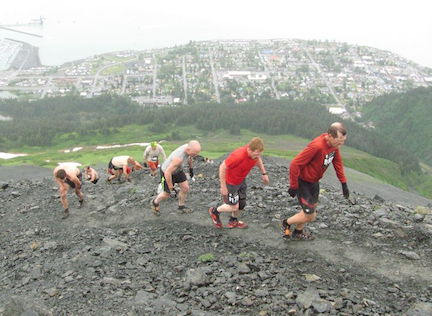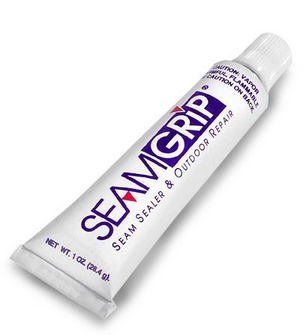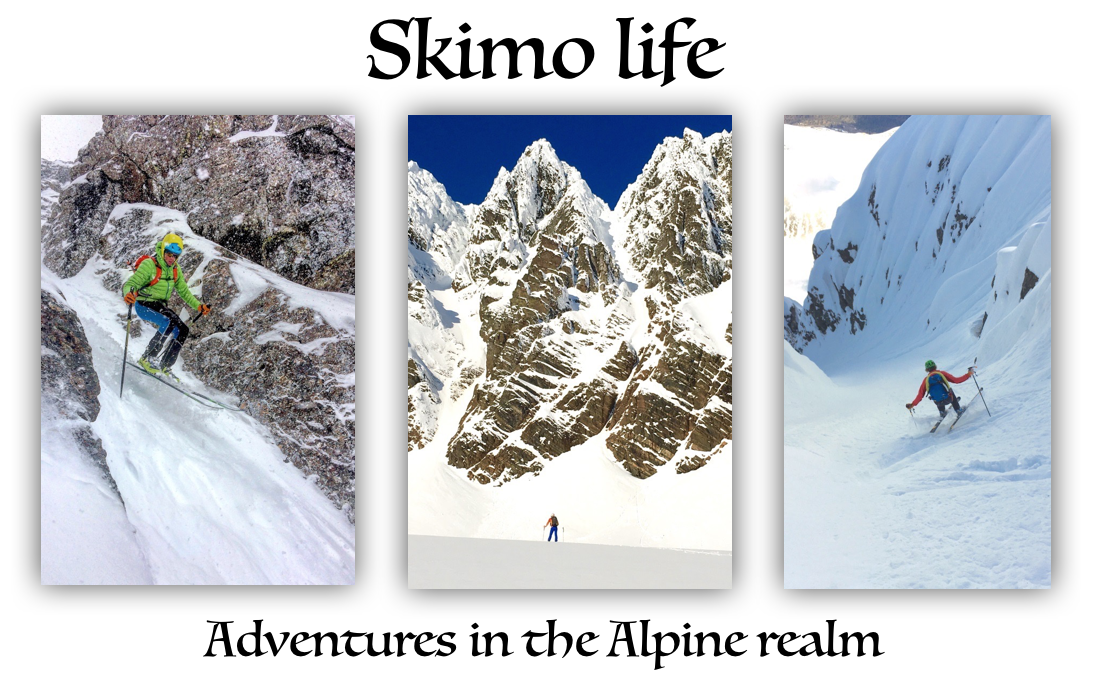Shoe Whore
 Monday, July 23, 2012 at 01:05AM
Monday, July 23, 2012 at 01:05AM  Shoe trials, 2012 Mount Marathon, Seward, AKUnlike cycling, the equipment end of the running game is kind of boring. Manufacturers do their best to convince us we "need" certain gear to be effective while engaging in foot travel but, really, it's a pretty Spartan activity. The one piece of gear we can't do without, however, is foot wear. The barefoot running movement notwithstanding, shoes provide runners an opportunity to geek out.
Shoe trials, 2012 Mount Marathon, Seward, AKUnlike cycling, the equipment end of the running game is kind of boring. Manufacturers do their best to convince us we "need" certain gear to be effective while engaging in foot travel but, really, it's a pretty Spartan activity. The one piece of gear we can't do without, however, is foot wear. The barefoot running movement notwithstanding, shoes provide runners an opportunity to geek out.
It's crazy how fast runners accumulate foot wear. I'm guilty. When you're new to the sport, there's a period of experimentation figuring out what works for you. Manufacturers are well aware of this and make a dizzying number of models and styles with sexy colors to further muddy the waters of selection. Thank god I don't run on the road as that would double my needs. Heaven forbid you run on pavement in "trail" shoes. Gasp!
Now a year into my second season, I'm getting a feel for what I like. I thought I would share some thoughts about my brief experience with several shoes over the last two seasons. This is no definitive review, mind you, just one novice's opinion of a few pairs of kicks, several of which he's managed to destroy in short order.
Lab Rat
First of all, the athlete. I'm pretty inexperienced at the running game, having only run as an off-season distraction over the years. Only in the last two summers has it been my main focus. It's also important to note that I don't run year around. This may serve to keep me from getting hurt with overuse issues but it also prevents me from getting particularly adept at the skill. So be it. I love to ski. But it has me re-learning things in the spring.
Although I have successfully adopted the mid to fore foot striking style of running, I haven't completely gone to the far end of minimalist foot wear. First of all, I think that running barefoot or in really minimal shoes like Vibram Five Fingers off-road is stupid. I mean, what are we trying to prove here? It's sort of like telemark skiing. I used to do that, too. Stupid. But I digress. Back to shoes. With little to no protection the toes and soles of one's feet are completely vulnerable to the insults of the trail. Why put yourself through that? A little protection, not to say anything of the wonders of traction soles and sticky rubber, can simply make the task of covering ground less risky. More thoughts on this here.
I also have a significantly damaged ankle from too many sprains over the years which has led to an unstable ankle (at times) and a collapsed arch in my right foot. This, in turn, leads to some stress on my Posterior Tibialis tendon as it tries to hold up my collapsing arch and pronating foot. Rather than wade through the pain of tendonitis here I've opted, albeit reluctantly, to put an arch support orthotic back in my shoe. I also wear an ankle brace on the right foot so I can worry less. Not so minimalist, I admit. But, hey, it keeps me out there with less problems.
Next, I don't have the typical runner physique. The best runners are light. There's no getting around the gravity issue and smaller dudes (and dudettes) simply run more easily. At around 175 lbs, I'm 30 lbs from ideal. Must be fun to be light and run that way. Oh well. In terms of shoes, however, this increased body mass puts a much greater demand on the equipment. Readers need to take this into account as I detail the break down of various shoes.
Terrain
Dina enjoying typical Chugach terrainI'm not strictly cruising on level or even rolling hiking trails. In the Chugach, the trails go UP…and steeply. The surfaces are either muddy or rocky. Once on the ridge lines, which is where I prefer to be (no bears up there!) I'm always scrambling, mixing in intermittent running with fourth and rarely fifth class climbing. The rock is sharp in this range and it beats the shit out of foot wear. With all the rain this summer, mud is common and snow fields are frequent up high. A shoe's performance in this slippery terrain is important.
Shoe Characteristics
Being a fan of "new school", fore foot striking running style, I prefer a low ramp, "small delta" shoe. This means that I don't want a traditional, cushy, thick heel. This shoe quality promotes heel striking, something I'm trying to avoid. Having a relatively flat sole makes it easier to run lightly. It also tends to create a lighter shoe with less material underfoot. I feel the stones but it forces a more thoughtful gait pattern. I'm not opposed to some protection underfoot but the change between the heel and fore foot should be less than 10mm for my tastes. More than that and I notice it.
I also find that with a thick heel and attempting to fore foot strike, I catch the heel coming through and trip more. This simply happens less often with flatter soles. Also, speaking of tripping, aggressive sole lugs can catch in bouldery terrain. There is no perfect sole. The lugs are great in the mud and snow but tend to creep on slabs making climbing in them less secure.
The Kicks
Being and old climber, I'm attracted to climbing shoe manufacturers. This doesn't mean they make the best shoes but they simply appeal to me emotionally. Five Ten entered the market over a decade ago and produced and running-like shoe. Not much to it and they've since diversified their efforts in other arenas like BMX, BASE jumping and other "action sports". Probably better that way. But that didn't keep me from burning through several pairs during my tenure with Exum Mountain Guides.
La Sportiva did the same thing years ago but stuck with it, developed their products extensively, attracted some high profile running athletes and now produce nice shoes that fill that climbing-centric need in me. Truth be told, these are full-on running shoes designed for running in the mountains. La Sportiva understands the nuances of sole rubber and addresses stickiness in their various models. This is important as terrain gets steeper, rockier and more technical. Your life can depend on this particular detail.
 In the Tetons, mud really isn't an issue. I only worried about rubber quality and tread design and how it impacts scrambling performance more than sloppy trail grip. One of the first shoes I tried last summer and gave another go this season is the Quantum by La Sportiva. This shoe has some sticky rubber but what sets it apart is the sole design. It's wavy and more cushy than most EVA mid soles and seems to absorb trail irregularities well. With my trick ankle, I like this quality. Delta - 11mm Weight - 380 gm.
In the Tetons, mud really isn't an issue. I only worried about rubber quality and tread design and how it impacts scrambling performance more than sloppy trail grip. One of the first shoes I tried last summer and gave another go this season is the Quantum by La Sportiva. This shoe has some sticky rubber but what sets it apart is the sole design. It's wavy and more cushy than most EVA mid soles and seems to absorb trail irregularities well. With my trick ankle, I like this quality. Delta - 11mm Weight - 380 gm.
The main problem with this shoe for a runner of my size is that there is significant sheer going on between the mid and outer sole and the sole eventually tears. These shoes only last me a week or two. Very disappointing. I think lighter runners will get more miles out of them. The sole design is also terrible in mud and snow, lacking the usual aggressive lugs that excel on these surfaces. This same lack of lugs, however, makes it scramble nicely on rock.
 After skidding around the Briggs Slab while soloing the Exum Ridge on the Grand Teton in my Quantums during a speed attempt, I thought I would try something with stickier rubber. The Raptor is billed as such a shoe. Unfortunately, the sole design is such that there are flexible mini lugs on the bottom that tend to creep when climbing making them unnerving for me. The heel is also more traditional and I noticed the height. I sold them to a friend who didn't care. Delta - 12mm Weight - 360 gm
After skidding around the Briggs Slab while soloing the Exum Ridge on the Grand Teton in my Quantums during a speed attempt, I thought I would try something with stickier rubber. The Raptor is billed as such a shoe. Unfortunately, the sole design is such that there are flexible mini lugs on the bottom that tend to creep when climbing making them unnerving for me. The heel is also more traditional and I noticed the height. I sold them to a friend who didn't care. Delta - 12mm Weight - 360 gm
Disappointed, I stepped up for another La Sportiva model, the Skylite 2.0. This is a light, more traditionally built shoe with a low ramp and more climbing friendly sole. This means it sucks in mud and snow but rules on slab and easy 5th class climbing. This is my pick if the terrain is going to require using my hands a lot.
The uppers sport this new thing La Sportiva is doing covering the laces. Not really sure what that's about. Looks sort of cool, in that dorky technical kind of way but there's no servicing the laces. And if you want to use a mini gaiter to keep rocks out of your shoes, you're out of luck if they clip onto your first lace at the toe. Oops. Outdoor Research mini gaiters out ... Salomon gaiters in. Delta - 6mm Weight - 295 gm
I used the credit for my returned Quantums to buy another pair of shoes. I went pretty minimalist on these. They're super light and the rubber is sticky. Montrail has been in the trail runner business for a long time and is keeping up with current market demands by building lighter, flatter shoes. My only complaint with the Rogue Racer, and it's a similar problem I have with all mesh uppers, is that my socks and feet get filthy after a dusty trail run. This is the nature of the beast. But I took these puppies on a 25 mile circumnavigation of the Teton Range last summer and had no foot issues. Delta - ? Weight - 240 gm
When I got to Anchorage and started running again, I knew I needed something for mud and snow. The mountain races I had my eye on all took place early in the spring so conditions were sloppy. Since La Sportiva shoes seem to fit my narrow feet, I went with the Crosslite with the super aggressive lug sole. They didn't disappoint. On steep, loose or muddy downhill I rarely slip. It's almost like having Velcro on your feet. Very secure. Delta - 10mm Weight - 326 gm
Like the true shoe whore I seem to be now, when I blew out my Quantums for the final time (after less than 20 hours) I used the store credit to try something new. I was momentarily tempted to give the Hoka a go but simply couldn't get around the height of the shoe. Although they sport a low ramp, they feel insecure on side hills to me and I feared for my ankles. Also, they don't seem like the ticket on technical terrain.
So, instead, I stepped up for the Fellcross. Although Salomon has been in the technical off-road running shoe business for years, I've never owned a pair until now. Like the name implies, these babies excel in muddy, snowy terrain. If the rock is dry, they're okay but if you find yourself on wet rock you'll be terrified. The lugs are aggressive and flexible. The rubber is very slick when wet. The lugs prevent much sole surface area from contacting the rock, the exact opposite of a smooth rock shoe.
In the conditions they were designed for, however, I love them. There is some protection underfoot but you still have to watch where you step. The uppers hold back some moisture better than the others in this review. I have upper break down issues with La Sportiva shoes but these Salomons seem to be holding up, so far. Maybe it's the super techie faux carbon sidewalls that are to blame. Sexy looking, for sure. No need for Seam Grip yet. Delta - 4mm Weight - 306
Repairs
So, that brings me to my final thoughts on premature shoe wear. I recommend inspecting them early and treating any weakness with Seam Grip.
The poly urethane in a tube product is my go-to fix-it for anything made of material. Forget Shoe Goo. It's too stiff. Seam Grip works better, IMO. And if you fail to recognize the problem until you have a blow out, simply back the hole with tape or sew the hole closed and apply a layer or two. Good as new and stronger than before. Saves you money in the long run. - Brian
 Brian |
Brian |  16 Comments |
16 Comments |  la sportiva,
la sportiva,  mountain running,
mountain running,  salomon in
salomon in  Gear
Gear 





Reader Comments (16)
Brian, interesting post. Your mention of a past ankle sprain triggered a thought. I suffered a terrible ankle sprain in July 2011. Took nearly 6 months to fully rehab, but it feels normal now. My issue is paranoia about doing it again. I was wearing low cut hiking shoes at the time . The orthopedist gave me an Axo brace to wear which works great in terms of preventing the ankle from rolling. I have been afraid to wear low cut shoes since. Am I being too cautious? As I mentioned in our exchange about nutrition, I am doing the Grand Canyon R to R this October (hiking, not running). I can either wear high top LW shoes or low top with the brace? Any thoughts? A doctor friend (not an orthopedist) thinks continued use of the brace will actually make the ankle weaker over time.
Dang, got enough shoes there, guy? Nice reviews, might help guide my next footwear purchase. Thanks.
Nice overview and post Brian. As a LS Fireblade lover for over 3 years now, I am currently on the hunt for a replacement to this now discontinued model. It's always nice to see and hear what others thoughts are on such nuances as mountain footwear of any kind. I've been messing around with various inov-8's as well as some newer LS models with varied success, but no outright winner as yet. Thanks as always for the write-up!
Jim,
Great question. I have a pretty strong opinion about this topic of ankle sprains and braces. I know, big surprise, right?
Anyway, I first blew my ankle in the 7th grade. I was in a cast for 6 weeks. It eventually returned to normal. Then, I had another severe sprain when I was about 18 and then many lesser events over the years. My ankle is what is known as "grossly unstable" in ortho speak. I'm scared to get another x-ray. I don't want to know.
I have worn braces over the years on and off. They definitely help a lot but I eventually get lazy and stop wearing them. And then I have another event and curse myself for not wearing it.
The problem is that these recurrent events can eventually lead to permanent damage to the articular cartilage in the ankle. This is a bad thing and is what I fear is going on in my ankle. You don't want this.
Your ankle is vulnerable, for sure. As a guy who works in orthopedics, I would recommend that you wear a figure-of-eight style brace whenever you're out hiking or running off road.
I don't think high top shoes make any difference at all so wear what you want. It opens up options, for sure. I use a McDavid brace I found at Sport Authority since I didn't like the ones we had at work. I find this style works best. It's probably the same design as the ASO. It's trim and seems to do the job while allowing normal ankle mechanics.
As for your ankle getting weaker as your friend suggests I would say that repeatedly blowing your ankle has far greater consequences than that. You're not wearing it all the time, anyway. Besides, the brace is not a cast. You still have fire the muscles that stabilize the joint. I get what he's saying but I regret not wearing my brace more now that the horse is out of the barn.
Adam,
Well, duh! Why do you think I call the post "Shoe Whore"? Gotta live up to the title.
Nick,
The Innov 8's are popular around here. Very freaking light! They seem to all have an aggressive tread which is great in the mud. Not much under foot, though, so I wonder if they are too light for my pansy-ass feet. Might have to try a pair next season as long as my current quiver holds up.
The La Sportiva Crosslite was the first shoe I tried when I began switching to a midfoot strike technique. Unfortunately the largest size they make was too small for my clydesdale feet, but I loved the traction for the Pacific Northwest. I am currently running in New Balance MT110s and they have been my favorite shoe so far. They have big lugs similar to the Crosslite, but the forefoot is a lot wider and the drop is only 4mm. I prefer shoes to be flat and the wider forefoot is more comfortable for me despite my relatively narrow feet. I have also found the synthetic upper to be very durable and have been using these shoes for backpacking trips in addition to running. The uppers are very breathable, which feels great, but your feet will get very dirty on dusty runs. I have also found these shoes to be really useful for hiking into ski routes because they are so light it is not a big deal to carry them in my pack the rest of the day.
Hey Mike,
Thanks for the comments. I remember running in some very expensive (at the time) and really cushy NB shoes back in '85 when I was in the military. I know they have stayed around but I have not seen the minimalist offerings. Those sound nice. No NB dealers in my area though. Good to have options.
I'm wondering if anyone knows whether LS, Inov-8, or Salomons have trail runners for wider feet? Appreciate the reviews!
Hi Diego,
Perhaps a reader can shed some light on this. I have flat, low volume feet so have never looked. My impression is that LS and Salomon are pretty narrow. Not sure about Inov-8. Saucony might have something. My brother has snow shoes for feet and they're what he used to use.
Any suggestions on brands or models that run narrow other than LaSportiva? LaSportiva doesn't cater to my size 14 (48) feet. I think the largest they go is 47, which just doesn't cut it for trail shoes.
JZ,
Thanks for reading. You know, I feel sorry for you guys with big dogs. Kinda like women with small feet looking for ski boots. You all just get the short end of the stick, selection wise. That said, I have a friend who was of average height and had exceedingly big feet for a climber. Maybe not as big as yours, however. But he ran a fair amount and I think he was usually wearing Adidas. That's about all I have for suggestions. Perhaps another reader will chime in. I would also check out various running forums. I bet there are tons of comments dealing with this issue. Good luck.
coming in @ 205# w/ size 13 feet, i've been stoked on the brooks cascadia for a coupla seasons now, which is about the closest thing i've found to being "minimilist-like" for the large framed folks attracted to mountain runs/scrambles. it handles most all the off-trail terrain here in the wasatch quite well. the Delta comes in at 12mm allowing for mid to forefoot strikes on the gentle-to-straight-ups and yet enough cushion for the heal when bombing the steeps. the heel may be an issue for the mid-to-forefoot strikers when running long flat events. it handles "5.easy" without complaint, however it handles not-so-good when class 5 technical edging is required. the traction pattern is average and could use some improvements. oh, and brooks runs the size up to a 15.
Brian,
Thanks for the advice on the ankle brace. I am going to go with that plus low tops for the Grand Canyon trip. In that regard, can you suggest some low top hikers that give decent protection? Since I will be fast hiking and not running, I don't think I need something ultralight. Thanks again!
Jim
Hey TB,
Thanks for the input. I'm glad someone with big dogs chimed in for some advice.
Jim,
I haven't purchased a shoe in the category you describe in years but I can give you some guidelines, I think.
For a single push effort in the Canyon, I would still lean toward a running shoe but a more traditional one with a "rock plate" mid sole. Montrail used to make a couple in this genre. Just flex them. They should feel pretty stiff under foot and that will give you the protection you want so you don't have to watch every step.
Although I love "approach" shoes for how they climb, they really don't walk that well. By necessity they are meant to climb well and, thus, have very little under the fore foot. Your feet will get beat up on long hike in those. So, I would say steer clear of approach shoes.
Instead, look a "hikers" from La Sportiva, North Face and Scarpa. You will certainly find something you like there. Good luck